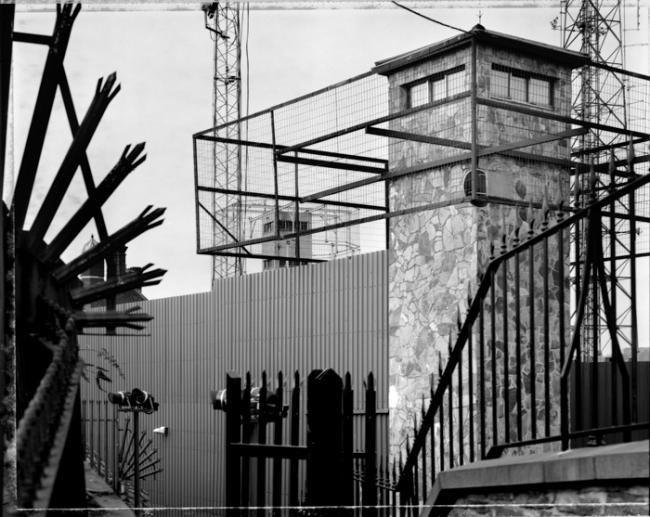Golf
Five Zero watchtower
Crossmaglen, South Armagh, Northern Ireland, 'Borucki Sanger'
1999
Jonathan
Olley
Castles Of Ulster
En 1997, le photographe Jonathan Olley obtient l'autorisation de photographier les casernes fortifiées et les tours de contrôle encore en service de l'armée britannique en Irlande du Nord. Nouveaux châteaux forts de l'Ulster pour Olley, Tom Paulin les qualifient de Martian spacecraft, symbolisant la complète défaite de la politique et des valeurs civiques. Aujourd'hui, la plupart de ces fortifications militaires ont été démantelées en réponse aux accords de paix.
▲ Forkhill Security force base Forkhill, South Armagh, Northern Ireland, UK.
Le journaliste Sean O'Hagan notait que beaucoup d'Irlandais estimaient qu'il fallait laisser en l'état ses postes fortifiés contrôlant les villes, ou ceux implantés au sommet des collines, ainsi que la célèbre prison de Maze, véritables monuments historiques dédiés à la mémoire d'une guerre anti-coloniale. Le gouvernement britannique jugea politiquement nécessaire de supprimer toutes les traces de sa présence militaire. Sean O'Hagan considère ainsi que "les extraordinaires images de Jonathan Olley pourraient bien devenir l'un des seuls témoignages, un rare aperçu d'un passé pas trop lointain." L'historien de l'architecture David Brett écrivait à propos de l'ingénierie politico-militaire : " Parce que ce dont il s'agit, c'est que la triste histoire de l'Irlande du Nord est inscrite dans la conception même de ces postes de police."
▲ Forkhill Security force base Forkhill, South Armagh, Northern Ireland, UK.
Le journaliste Sean O'Hagan notait que beaucoup d'Irlandais estimaient qu'il fallait laisser en l'état ses postes fortifiés contrôlant les villes, ou ceux implantés au sommet des collines, ainsi que la célèbre prison de Maze, véritables monuments historiques dédiés à la mémoire d'une guerre anti-coloniale. Le gouvernement britannique jugea politiquement nécessaire de supprimer toutes les traces de sa présence militaire. Sean O'Hagan considère ainsi que "les extraordinaires images de Jonathan Olley pourraient bien devenir l'un des seuls témoignages, un rare aperçu d'un passé pas trop lointain." L'historien de l'architecture David Brett écrivait à propos de l'ingénierie politico-militaire : " Parce que ce dont il s'agit, c'est que la triste histoire de l'Irlande du Nord est inscrite dans la conception même de ces postes de police."
▲ Newtownhamilton Barracks. Newtownhamilton, South Armagh, Northern Ireland, UK.
A military building including the 'Supersangar' watchtower built in 1994 forming part of the British Army's defensive strategy to control the landscape and people of Northern Ireland.
▲ British Army Security force base. Bishops Gate, Derry City Walls, Londonderry, Northern Ireland, UK.
▲ Forkhill Security force base Forkhill, South Armagh, Northern Ireland, UK.
Starting as little more than huts perched on flimsy scaffolding structures, the watchtowers developed into much more substantial installations housing sophisticated equipment such as video and still cameras, computers, telescopes, communications aerials and helicopter-refuelling facilities. Although watchtowers were also erected in other border and some city areas, only in South Armagh is there such a concentration. Their genesis lay in the early Army practice of setting up static observation posts (OPs) on high ground to monitor the routes between Crossmaglen and the border.
▲ Mountpottinger Road RUC station, Belfast,Co.Down, Northern Ireland, UK.
▲ Magilligan Ranges, Magilligan Point, County Londonderry, Northern Ireland, UK.
Jonathan Olley
Castles Of Ulster
Site internet :
Site internet :







Aucun commentaire:
Enregistrer un commentaire